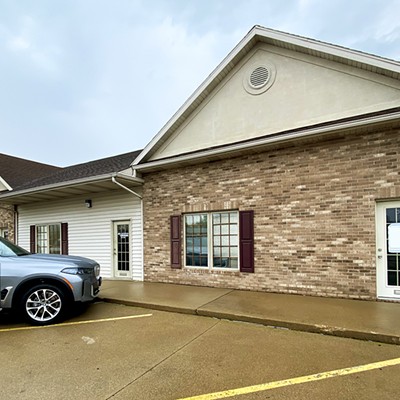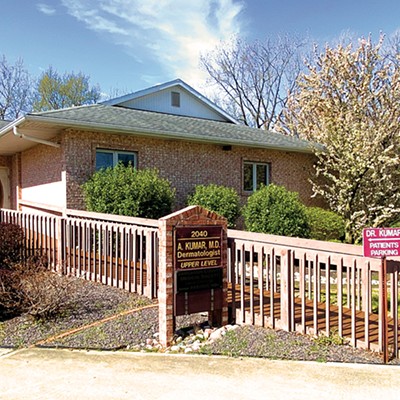
Anyone breeding dogs and cats for sale in Springfield would have to register with the city as part of an effort to reduce the number of unwanted animals ending up in the Sangamon County Animal Control Center.
An ordinance proposed by Ward 8 Ald. Erin Conley is designed to give city officials information about the number of "backyard breeders" of animals – mainly dogs – and promote responsible breeding practices in this unregulated, underground and often-lucrative industry.
"We have no idea how many people are breeding in our community," Conley said at the council's March 27 committee of the whole meeting. "We don't know what numbers they're producing. We have no idea how the pipeline works. We have no handle on it."
It's unclear whether the ordinance will pass. Several council members said they hadn't heard complaints about backyard breeders before and were unaware of the problem.
Alderpersons Chuck Redpath of Ward 1, Larry Rockford of Ward 4, Brad Carlson of Ward 7, Jim Donelan of Ward 9 and Ralph Hanauer of Ward 10 specifically said they doubted such an ordinance was needed or would address the problems of unscrupulous breeders and unwanted pets.
"We have bigger fish to fry," Rockford said.
Ward 3 Ald. Roy Williams Jr. said he worried how much city staff time would be required to maintain the registration system and crack down on violators.
Supporters of the proposal said council members may not be familiar with the animal overpopulation problem unless they have visited the animal control center or the nonprofit Animal Protective League shelter in Springfield.
Conley has delayed a council vote on her ordinance for at least several weeks while the issue is studied. She said she got the idea for it after talking with animal welfare groups and county officials.
The proposal would require a $100-per-year registration fee for breeders of one or more animals, though Conley said she is willing to adjust the final proposal to reduce or eliminate the fee. Breeders violating the ordinance could be cited and face potential fines of $100 to $500.
Springfield resident Marc Ayers, Illinois director for the Humane Society of the United States and a Sangamon County Board member representing District 12, told the council he supports Conley's proposal because there are many backyard breeders whose main interest is the hundreds to thousands of dollars they can receive for each puppy.
These dog breeders are different from the breeders of six or more females who pay $350 for an initial state license and $100 for annual renewals, Ayers said.
Backyard breeders often wear out their breeding females, produce too many puppies and don't go through the time and expense to get the puppies shots, microchips or sterilization procedures, Ayers said.
The breeders also tend not to interview potential buyers for suitability and won't take back any animals, he said. As a result, some of the animals become strays and are picked up by animal control or surrendered by owners to shelters, Ayers said.
An ordinance would put backyard breeders "on notice" that there is some oversight and pave the way for future regulations and educational efforts to encourage better conduct, Ayers said.
"They are pumping our system full of dogs," he said. "The goal is to stop this spigot a little bit."
Ayers said he would like the County Board to adopt a countywide breeder registration system. However, he said he was told by the board's legal counsel that the county government doesn't have the right under Illinois law to adopt such a system.
There's no dispute Springfield city government could start such a system because of the City Council's home-rule powers.
"This is the first step to begin wrapping ourselves around this problem," Ayers said. "This ordinance is a huge step in the right direction."
Ayers, a Democrat on the Republican-controlled County Board, said he was frustrated by Sangamon County's interpretation of state law. Whiteside County, about 200 miles north of Sangamon County, adopted a dog breeder registration ordinance in 2018 that is similar to, and in some ways broader than, the one proposed for Springfield, he said.
Cheryl Lee, chief executive officer of the Whiteside County Health Department, said the county's legal advisers raised no concerns about the legality of a countywide animal breeder ordinance.
In Whiteside County, with a population of about 56,000 people, breeders are charged $100 per year. Operating and enforcing the system hasn't created a need for more staff at the health department, Lee said. Sangamon County's population is 196,000.
The Whiteside County Health Department's dog kennels remain full, but the county encounters fewer "major issues" with breeders since the ordinance took effect, Whiteside Animal Control Director James Garcia said.
Ayers said the unwanted pet situation, which has kept Sangamon County's animal control center full for years, "really exploded" locally and nationally because of the COVID-19 pandemic.
Animals adopted for companionship during the COVID-19 pandemic were turned in at shelters as people returned to the office, found they didn't have the time for a pet or couldn't afford pet food and related care as inflation sent costs soaring, Ayers said.
Caitlin Graham, the volunteer vice president of Springfield-based WILD Canine Rescue, said about 20 of the 30 backyard breeders in Sangamon County operate in Springfield. She estimated that the breeders produce 900 to 1,800 puppies a year, and many end up in local shelters.
About 96% of dogs that come to the center are from Springfield, according to John Ridley, director of the Sangamon County Department of Public Health.
In recent days, the center at 2100 Shale St. held 93 dogs in a building designed to house 85. The center also was caring for 38 cats.
The average daily census before the pandemic was 70 to 75 dogs and about 25 cats, Ridley said.
Ninety percent or more of the dogs and cats are adopted out within 15 days, Ridley said, although the center has dogs that have been there more than six months.
Animals are euthanized "as a last resort due to medical or behavioral issues," he said.
The County Board hasn't taken a stand on Conley's proposed ordinance, and Ridley wouldn't endorse it. But he said backyard breeding "does present challenges to us and the city."
Ridley said mandatory breeder registration in Springfield could be "a component" of a multifaceted strategy that he is working on with various groups to reduce the overpopulation problem affecting the animal control center.
"For the most part, people in the county do a nice job of keeping their animals as they should," he said. "It doesn't take too many people to create a little bit of an issue."
Dean Olsen is a senior staff writer at Illinois Times. He can be reached at 217-679-7810, [email protected] or twitter.com/DeanOlsenIT.


















